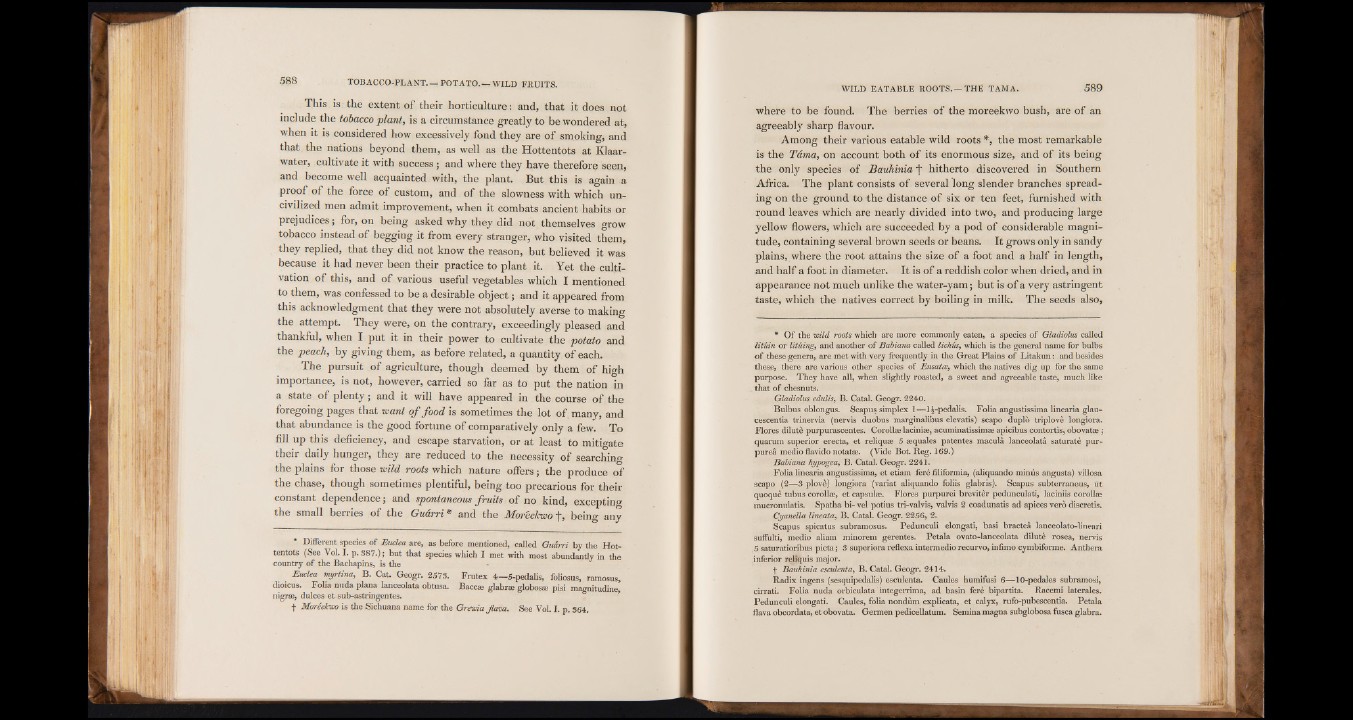
This is the extent of their horticulture: and, that it does not
include the tobacco plant, is a circumstance greatly to be wondered at,
when it is considered how excessively fond they are of smoking, and
that the nations beyond them, as well as the Hottentots at Klaar-
water, cultivate it with success; and where they have therefore seen,
and become well acquainted with, the plant. But this is again a
proof of the force of custom, and of the slowness with which uncivilized
men admit improvement, when it combats ancient habits or
prejudices; for, on being asked why they did not themselves grow
tobacco instead of begging it from every stranger, who visited them,
they replied, that they did not know the reason, but believed it was
because it had never been their practice to plant it. Yet the cultivation
of this, and of various useful vegetables which I mentioned
to them, was confessed to be a desirable object; and it appeared from
this acknowledgment that they were not absolutely averse to making
the attempt. They were, on the contrary, exceedingly pleased and
thankful, when I put it in their power to cultivate the potato and
the peach, by giving them, as before related, a quantity of each.
The pursuit of agriculture, though deemed by them of high
importance, is not, however, carried so far as to put the nation in
a state of plenty; and it will have appeared in the course of the
foregoing pages that want of food is sometimes the lot of many, and
that abundance is the good fortune of comparatively only a few. To
fill up this deficiency, and escape starvation, or at least to mitigate
their daily hunger, they are reduced to the necessity of searching
the plains for those wild roots which nature offers; the produce of
the chase, though sometimes plentiful, being too precarious for their
constant dependence; and spontaneous fruits of no kind, excepting
the small berries of the Guam * and the Moreehwo f, being any
* Different species of Evclea are, as before mentioned, called Guirri by the Hottentots
(See Vol. I. p. 387.); but that species which I met with most abundantly in the country of the Bachapins, is the
Evclea myrtina, B. Cat. Geogr. 2573. Frutex 4—5-pedalis, foliosus, ramosus,
dioicus. Folia nuda plana lanceolata obtusa. Baccae glabrae globosae pisi magnitudine, nigrae, dulces et sub-astringentes.
f Moreehno is the Sichuana name for the G remajlava. See VoL I. p. 364.
where to be found. The berries of the moreekwo bush, are of an
agreeably sharp flavour.
Among their various eatable wild roots *, the most remarkable
is the Tama,) on account both of its enormous size, and of its being
the only species of Bauhinia f hitherto discovered in Southern
Africa. The plant consists of several long slender branches spreading
on the ground to the distance of six or ten feet, furnished with
round leaves which are nearly divided into two, and producing large
yellow flowers, which are succeeded by a pod of considerable magnitude,
containing several brown seeds or beans. It grows only in sandy
plains, where the root attains the size of a foot and a half in length,
and half a foot in diameter. It is of a reddish color when dried, and in
appearance not much unlike the water-yam; but is of a very astringent
taste, which the natives correct by boiling in milk. The seeds also,
* Of the wild roots which are more commonly eaten, a species of Gladiolus called
lituin or lining, and another of Babiana called lichhs, which is the general name for bulbs
of these genera, are met with very frequently in the Great Plains of Litakun: and besides
these, there are various other species of Ensatce, which the natives dig up for the same
purpose. They have all, when slightly roasted, a sweet and agreeable taste, much like
that of chesnuts.
Gladiolus edulis, B. Catal. Geogr. 2240.
Bulbus oblongus. Scapus simplex 1—1^-pedalis. Folia angustissima linearia glau-
cescentia trinervia (nervis duobus marginalibus elevatis) scapo duplb triplove longiora.
Flores dilute purpurascentes. Corollae laciniae, acuminatissimse apicibus contortis, obovatae;
quarum superior erecta, et reliquae 5 sequales patentes macula lanceolata saturate purpurea
medio flavido notatae. (Vide Bot. Reg. 16*9.)
Babiana hypogea, B. Catal. Geogr. 2241.
Folia linearia angustissima, et etiam fere filiformia, (aliquando minus angusta) villosa
scapo (2—3 plove) longiora (variat aliquando foliis glabris). Scapus subterraneus, ut
quoque tubus corollae, et capsulae. Flores purpurei breviter pedunculati, laciniis corollae
mucronulatis. Spatha bi- vel potius tri-valvis, valvis 2 coadunatis ad apices vero discretis.
Cyanella lineata, B. Catal. Geogr. 2256, 2.
Scapus spicatus subramosus. Pedunculi elongati, basi bractea lanceolato-lineari
suffulti, medio aliam minorem gerentes. Petala ovato-lanceolata dilute rosea, nervis
5 saturatioribus picta; 3 superiora reflexa intermedio recurvo, infimo cymbiforme. Anthera
inferior reh<quis major.
f Bauhinia esculenta, B. Catal. Geogr. 2414.
Radix ingens (sesquipedalis) esculenta. Caules humifusi 6— 10-pedales subramosi,
cirrati. Folia nuda orbiculata' integerrima, ad basin fere bipartita. Racemi laterales.
Pedunculi elongati. Caules, folia nondum explicata, et calyx, rufo-pubescentia. Petala
flava obcordata, et obovata. Germen pedicellatum. Semina magna subglobosa fusca glabra.